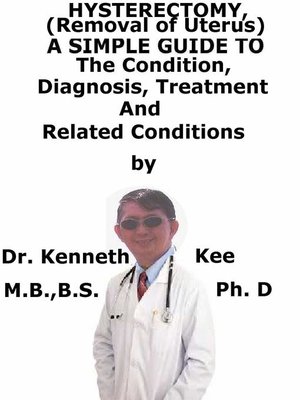Hysterectomy, (Removal of Uterus) a Simple Guide to the Condition, Diagnosis, Treatment and Related Conditions
ebook
By Kenneth Kee

Sign up to save your library
With an OverDrive account, you can save your favorite libraries for at-a-glance information about availability. Find out more about OverDrive accounts.
Find this title in Libby, the library reading app by OverDrive.



Search for a digital library with this title
Title found at these libraries:
| Library Name | Distance |
|---|---|
| Loading... |
Hysterectomy is the surgery to remove the whole uterus.It may be done through:1. Vaginal hysterectomyA surgical cut in the vagina, and using a laparoscope2. Abdominal hysterectomyA surgical cut in the belly (called open or abdominal)3. Laparoscopic hysterectomyThree to four small surgical cuts in the belly and then using a laparoscope4. Robotic hysterectomyThree to four small surgical cuts in the belly, in order to perform robotic surgeryThe patient and the doctor will have to select which form of procedure is suitable.The selection will be dependent on the medical history and the reason for the surgery.It may be a choice if the patient does not want children, medicines do not work, or the patient cannot have any other interventions.The main types of hysterectomy are.1. Total hysterectomyDuring a total hysterectomy, the uterus (womb) and cervix (neck of the womb) is removed.2. Subtotal hysterectomyA subtotal hysterectomy requires excising the main body of the uterus and leaving the cervix behind3. Total hysterectomy with bilateral salpingo-oophorectomyA total hysterectomy with bilateral salpingo-oophorectomy is a hysterectomy requiring removal of:a. The fallopian tubes (salpingectomy)b. The ovaries (oophorectomy)4. Radical hysterectomyA radical hysterectomy is normally carried out to eliminate and treat cancer when other treatments such as chemotherapy and radiotherapy are not effective or have not succeeded.During the surgery, the body of the uterus and cervix is excised, along with:a. The fallopian tubesb. Part of the vaginac. Ovariesd. Lymph glandse. Fatty tissueThe most frequent reasons for having a hysterectomy are:1. Heavy periods – which can be induced by fibroids2. Pelvic pain – which may be produced by endometriosis, pelvic inflammatory disease (PID), adenomyosis or fibroids3. Prolapse of the uterus4. Cancer of the uterus, ovaries or cervix5. Heavy mensesPreoperative Details1. Stop smoking2. Eat a healthy, balanced diet3. Exercise regularly4. Lose weightThe patient may be requested to stop taking aspirin, ibuprofen (Advil, Motrin), clopidogrel (Plavix), warfarin (Coumadin), and any other drugs similar to thesePostoperative DetailsFollowing surgery, the patient will be prescribed pain medicines.The patient may also have a tube, termed a catheter, passed into the bladder to pass urine.The patient will be asked to move around as soon as possible following the surgery.The patient may go back to a normal diet as soon as the patient can without inducing nausea and vomiting.The duration that the patient stays in the hospital is dependent on the type of hysterectomy.The patient can probably go home the next day when surgery is done through the vagina using a laparoscope or following robotic surgery.When a larger surgical incision in the abdomen is made, the patient may require staying in the hospital 1 to 2 days.Following a hysterectomy, the patient may have some temporary side effects:1. Bowel and bladder disturbancesIt is advised that the patient drinks plenty of fluids and increases the fruit and fiber in the diet to help with the bowel and bladder movements.2. Vaginal dischargeFollowing a hysterectomy, the patient will have some vaginal bleeding and discharge.Average recovery times are:Abdominal hysterectomy: 4 to 6 weeksVaginal hysterectomy: 3 to 4 weeksRobot-assisted or total laparoscopic hysterectomy: 2 to 4 weeksA hysterectomy will cause menopause if the patient also have the ovaries removed.TABLE OF CONTENTIntroductionChapter 1 HysterectomyChapter 2 CausesChapter 3 SymptomsChapter 4 DiagnosisChapter 5 TreatmentChapter 6 PrognosisChapter 7 Uterine CancerChapter 8 Uterine FibroidEpilogue







